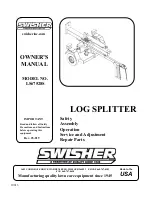
model no.
060-0550-6
| contact us: 1.866.523.5218
model no.
060-0550-6
| contact us: 1.866.523.5218
51
O
Pe
RA
TION
OPeRATION AT HIGH ALTITUDe
The density of air at high altitude is lower than at sea level. Engine power is reduced as the
air mass and air-fuel ratio decrease. Engine power and log splitter output will be reduced
approximately 3½% for every 1000 ft. of elevation above sea level. This is a natural trend
and cannot be changed by adjusting the engine. At high altitudes increased exhaust
emissions can also result due to the increased enrichment of the air fuel ratio. Other high
altitude issues can include hard starting, increased fuel consumption and spark plug
fouling.
To alleviate high altitude issues other than the natural power loss, CPE can provide a
high altitude carburetor main jet. The alternative main jet and installation instructions can
be obtained by contacting our Technical Support Team. Installation instructions are also
available in the Technical Bulletin area of the CPE website.
The part number and recommended minimum altitude for the application of the high altitude
carburetor main jet is listed in the table below.
In order to select the correct high altitude main jet it is necessary to identify the carburetor
model. For this purpose, a code is stamped on the side of the carburetor. Select the correct
high altitude jet part number corresponding to the carburetor code found on your particular
carburetor.
Carb Code
High Alt. Jet Part Number
Min. Altitude
100730983-0002
100092470
3281-9843 ft. (1000-3000 m)
WARNING: Operation using the alternative main jet at elevations lower than the recommended
minimum altitude can damage the engine. For operation at lower elevations, the originally supplied
standard main jet must be used. Operating the engine with the wrong engine configuration at a
given altitude may increase its emissions and decrease fuel efficiency and performance.





































